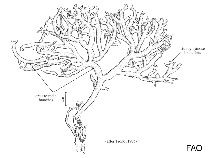Gracilaria arcuata Zanardini
Arcuate gracilaria| Native range | All suitable habitat | Point map | Year 2050 |

|
| This map was computer-generated and has not yet been reviewed. |
| Gracilaria arcuata AquaMaps Data sources: GBIF OBIS |
Upload your photos
Google image | No image available for this species;
drawing shows typical species in Gracilariaceae.
Google image | No image available for this species;
drawing shows typical species in Gracilariaceae.
Classification / Names Common names | Synonyms | CoL | ITIS | WoRMS
Florideophyceae | Gracilariales | Gracilariaceae
Environment: milieu / climate zone / depth range / distribution range Ecology
Sessile; depth range 0 - 7 m (Ref. 102160). Tropical
Distribution Countries | FAO areas | Ecosystems | Occurrences | Introductions
Indo-Pacific, Atlantic Ocean and the Mediterranean.
Length at first maturity / Size / Weight / Age
Maturity: Lm ? range ? - ? cm
Short description Morphology
Thalli erect, cartilaginous, greenish purple, with a discoid holdfast. Primary and secondary branches prominent, mostly arcuate, terete throughout, slightly constricted at the base. Branching on the main axes generally secund. Terminal branches giving rise to 2 or 3 short, stubby, spinose branchlets at their distal portions. Thalli up to 10 cm in height (Ref. 80758).
Used for human consumption: source of agar; used in wastewater purification; contains growth regulator substances similar to auxin, gibberellin, and cytokinin; used as manure for coconuts and coffee bushes in Hainan, India, and Sri Lanka (Ref. 80758). Grows in shallow subtidal areas attached to coral rocks and fragments, and shells (Ref. 80758).
Life cycle and mating behavior Maturity | Reproduction | Spawning | Eggs | Fecundity | Larvae
Main reference
References | Coordinator | Collaborators
Guiry, M.D. and G.M. Guiry. 2009. (Ref. 80701)
IUCN Red List Status (Ref. 130435)
CITES status (Ref. 108899)
Not Evaluated
CMS (Ref. 116361)
Not Evaluated
Threat to humans
Harmless (Ref. 80758)
Human uses
Fisheries: commercial
| FishSource |
Tools
More information
Internet sources
BHL | BOLD Systems | CISTI | DiscoverLife | FAO(Publication : search) | Fishipedia | GenBank (genome, nucleotide) | GloBI | Gomexsi | Google Books | Google Scholar | Google | PubMed | AlgaeBase | Tree of Life | Wikipedia (Go, Search) | Zoological Record
Estimates based on models
Preferred temperature
(Ref. 115969): 18.9 - 29.3, mean 28 (based on 3744 cells).



